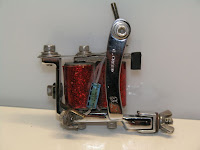In the early 90's I was a Member of the then E.T.A.A. (European Tattoo Artists Association) which was based in England.
As a Member you'd get a Newsletter which included interviews with various Artists, Tips & Tricks, etc.
Being as this was a Trade Only Newsletter, there were adverts by various Tattoo Artist, some were selling Machines.
One of those Tattoo Artists selling Machines was Micky Sharpz.
At that time, I'd read several glowing reports on how well Micky Sharpz Machines performed.
Also there was recommendations from some of England & Europe's leading Tattoo Artists who were using them too.
But there was no one that I knew personally here in Australia with any of Micky Sharpz Machines, so it would always be a gamble if his Machines would work that well for me?
There was only one model that was reasonably light in weight, made of iron, & came unplated, it was also offered with a really interesting style of Quickchange.
Of course all of the Micky Sharpz Machines were fitted with a Heavy Armature, but going by photos, this ones geometry looked good, so conversion into Thin Armature was always possible.
So based on all of that, I decided to buy one of his Machines & give it a try.
This Machine had a particular model name, but after nearly 20 years, I can't remember what it was now??
Update: I've since been reliably informed the model name for this particular Machine was a Hornet.
A Big Thanks goes to Josh Roelink for providing me with that bit of info.
I also ended up modifying the Quickchange as it's original Stud was in an awkward position to lock it up tight.
So with a new Stud welded at a better position, it meant I could easily rotate it closed with my Right Thumb.
When I sold everything, this Machine was still a "work in progress" as it didn't run quite as smooth as I'd have liked it to...
...from memory, my next option was to try swapping out those original Coils to see it that might have helped...
...or possibly just rewind those original ones. (swaps are far quicker & easier to do)
Almost 20 years on, this is how it looks today...a little bit of surface rust, but otherwise OK.
So with a new Stud welded at a better position, it meant I could easily rotate it closed with my Right Thumb.
When I sold everything, this Machine was still a "work in progress" as it didn't run quite as smooth as I'd have liked it to...
...from memory, my next option was to try swapping out those original Coils to see it that might have helped...
...or possibly just rewind those original ones. (swaps are far quicker & easier to do)
Almost 20 years on, this is how it looks today...a little bit of surface rust, but otherwise OK.
 |
| 90's model Micky Sharpz Machines known as the "Hornet" with it's interesting Quickchange |
 |
| The other side of the "Hornet" Machine |
This Machine ended up becoming an extra & would sometimes be used as a Round Shader.
More of my Old Machines in the next post...














